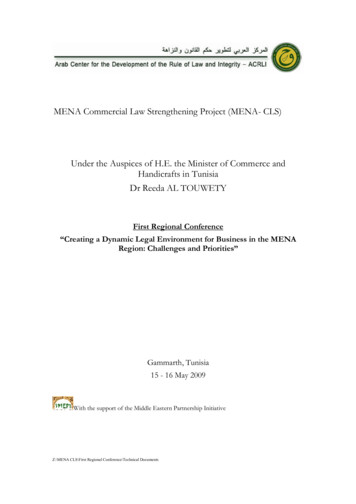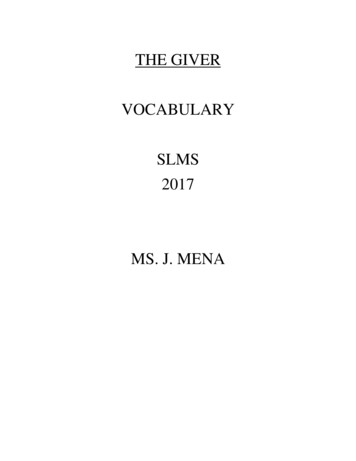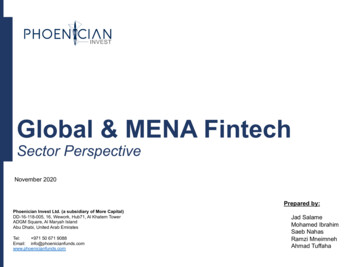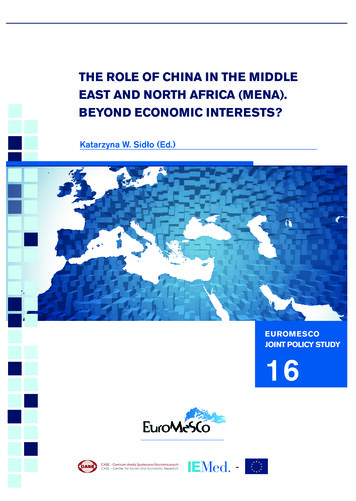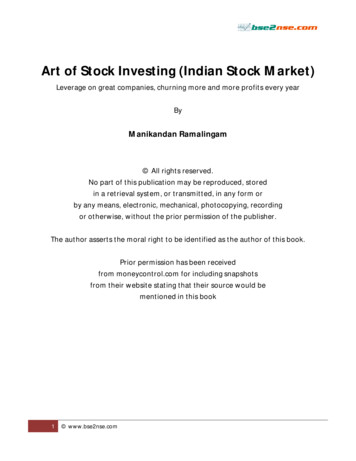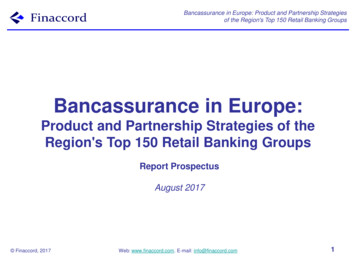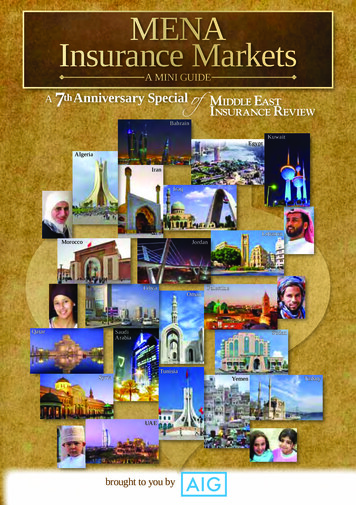
Transcription
MENAInsurance MarketsA Mini Guidea7th Anniversary Special aSyriaYemenUAEbrought to you byTurkey
MENAInsurance MarketsA Mini Guidea7th Anniversary Specialofbrought to you by
MENAINSURANCECLUBMr Yassir AlbaharnaChief Executive Officer,Arig, BahrainSteering CommitteeH.E. Dr Bassel HindawiImmediate Past InsuranceCommissioner, InsuranceCommission of JordanMr Sivam SubramaniamEditor-in-Chief,Middle East InsuranceReview, SingaporeMembersMr Ayman Adel El HoutGroup Vice President - Operations,Medgulf,BahrainMr Fady ShammasChief Executive Officer,Arabia Insurance Company S.A.L.,LebanonMr Fahad Al-HesniManaging Director & Chief ExecutiveOfficer,Saudi Reinsurance Company,Saudi ArabiaMr Farid ChedidChief Executive Officer,SEIB Insurance & ReinsuranceCompany,QatarMr Fateh BekdacheVice Chairman & General Manager,Arope Insurance S.A.L.,LebanonMr Imad Abdel KhaleqGeneral Manager,Jordan Insurance Company,JordanMr Mahmood Al SoufiChief Executive Officer,Bahrain National Holding CompanyBSC,BahrainMr Mahomed AkoobManaging Director and Chief Executive Officer,Hannover ReTakaful B.S.C (c),BahrainDr Michael BitzerChief Executive Officer,National Health Insurance Company Daman,UAEMr Michael GertschChief Executive Officer,Gulf Re,UAEMr Nagib M BahousPresident & Chief Executive Officer,MIG Group,BahrainMr Patrick ChoffelChief Executive Officer,Oman Insurance Company PSC, UAEMr Tarek A Hayel SaeedGeneral Manager,United Insurance Company,YemenMr Walid A SidaniChief Executive Officer,Abu Dhabi National Insurance Company,UAEMr Wasef JabshehChief Executive Officer,International General d by
ForewordMiddle East Insurance Review (MEIR) celebrates itsseventh anniversary since its launch in September2006 during the heydays of the high oil prices andinfrastructural boom in the MENA region. The boomwas so powerful that every major insurer and reinsurerwas bound for the Middle East.But what a difference seven years makes. Marketprospects are now more muted with the persistent ArabSpring moving into the Summer of Discontent, withtwo big countries still in a state of war and uncertainty,though Dubai has resoundingly recovered from thepangs of the global financial crisis. Takaful has alsogrown from its heydays of jubilant promises to be calledto account for its returns and impact.Looking back, we at MEIR are very proud to havesurvived the entire seven years, though many publishersand competitors have come and gone, slowed down tobi-monthly or just become virtual, and some have evenbecome just a mirage. We have even outlived several bigMNCs which had rushed into the heat of the region onlyto be burnt out quickly.In the seven years we have been covering marketdevelopments and introducing all the players from thevarious nooks and corners of the region to the world, wehave seen the market stagnate in some areas and regressin others but move forward in many more areas.Just for the record: the market has grown fromUS 20.4 billion to 44.1 billion between 2006 and2012. Although penetration has remained flat at 1.5%,insurance density has increased from 170.1 to 305.7during the period. The life business remains small butgreater attention is being paid to it and we are spreadingthe word.I salute many of the outstanding CEOs, both localsand foreigners, who have gone out of their way to boost3
professionalism and standards in the market. Amongthe key developments in the market, growth aside, isthe slew of regulations, the growing voice for uniformand actual enforcement of rules and the birth of theMENA Insurance CEO Club (MICC), aimed at providingthought leadership to the MENA insurance industry. Thepresence of such a dedicated pool of volunteers can onlyaugur good tidings for the industry and MEIR is proud tohave been chosen as the Secretariat to this Club that hashosted important milestone conferences for the regionlike the Political Risks Seminar and the Social MediaConference, both aimed at keeping the industry on itstoes to respond to the needs of the day.4Over the past seven years and 84 monthly editions,MEIR has kept the faith in the market through thickand thin, and is confident of brighter days ahead as theindustry gets more professional and more responsive tothe changing needs of society and economy. We will bethere to keep you posted of the next stage of developmentand zero in on all the key little critical and inspiringdevelopments and nitty gritties in the market. You willnever have to walk alone as a subscriber of MEIR withour arsenal of products to support your drive to boostyour competitive edge to win in the long term!And so it is with pride and commitment that we presentour Third Mini Guide to the MENA Insurance Marketsas a concise fact book on 20 markets in the region. Wehope this up-to-date information will serve the needs ofpractitioners in the market and those keen to do businessin the MENA region.Sivam SubramaniamEditor-in-Chief,Middle East Insurance Review
Message from SponsorWelcome to Middle East Insurance Review’s guide tothe insurance markets across the Middle East and NorthAfrica (MENA) region.This guide is a well-established and importantreference tool for insurance practitioners, providing keydetails of each market in the MENA region.AIG is proud to sponsor this guide and has maintaineda presence in the MENA region for over 50 years,providing insurance solutions for both consumers andcorporate clients and transacting business across theMiddle East and North Africa.Currently, AIG has operations in eight countries acrossMENA – Bahrain, Egypt, Kuwait, Lebanon, Oman,Qatar, Saudi Arabia and the United Arab Emirates.Over the last few years AIG has been recognisedacross the MENA region by the business communityas well as the insurance industry. AIG was namedEgypt Insurer of the Year, Kuwait Insurer of the Yearand MENA Financial Lines insurer of the year withrecognition for our strong customer focus, excellencein claims management, market leading products andinsurance capacity. Most recently, AIG received theMENA Product Innovation award for the launch ofCyberEdge Insurance, a first such product for the MENAregion.AIG is committed to the long-term development ofthe region and the respective insurance markets, and isconfident that we will continue to see strong growth ofthe insurance industry over the next few years.Michael WhitwellPresident, MEA,AIG5
6
ContentsInsurance statistics of MENA countries Qatar36Saudi 0Sources527
Insurance statisticsof MENA countries 2012Totalpremiums(US million)% growthoverpreviousyear% ofworldmarketshareMiddle East 40.16Saudi Middle EastNorth Africa otal World4,612,5141.0100.00Sub-totalNorth AfricaMENAAsiaincl JapanAfrica
Life% growthpremiumsover(US previousmillion)year% ofworldmarketshareNon-life % growthoverpremiums(US previousmillion)year% ofworldmarketshareMiddle East (ME)TurkeyIranUAESaudi 41,927-2.50.10EgyptSub-totalMiddle EastNorth Africa 00.06Tunisia123-2.40.00694-2.40.03Sub-totalNorth 606.21.87Asiaincl 133.072,620,8640.4100.001,991,6501.9100.00Total WorldSource: Swiss Re sigma No 3/20139
Insurance statisticsof MENA countries 2012Insurance penetration (Premiums as a % of e East .370.221.15Oman1.010.170.84Saudi .40Average (ME)1.480.261.23Morocco2.950.961.99North Africa 70.050.62Average (NA)1.540.401.14Average (MENA)1.500.301.20Asia incl. .84Total (World)6.503.692.81
Insurance density (Premiums per capita in US .2293.91,170.3Middle East 20.1Saudi 6100.2Jordan102.59.693.0Average (ME)406.067.2338.887.628.559.1North Africa ypt21.79.412.3Average (NA)55.013.042.0Average (MENA)305.751.7254.0Asia incl. 5.7372.6283.1AfricaEuropeTotal (World)Source: Swiss Re sigma No 3/201311
Algeria12GDPUS 207.8 billion (2012 est.)GDP real growth rate2.5% (2012 est.)Population38,087,812 (July 2013 est.)Age structure (2013 est.)0-14 years: 28.1%15-24 years: 18.1%25-54 years: 42.7%55-64 years: 6%65 years and over: 5.1%Insurance regulatorInsurance Regulatory Authority,Ministry of FinanceInsurance associationNational Insurance Council (CNA)Minimum capital requirementsLife insurers: DZD1 billion(US 12.4 million)Non-life insurers: DZD2 billionReinsurers: DZD5 billionTotal number of insurers/reinsurers23Premiums (Life)US 89 million (2012)Premiums (Non-life)US 1,161 million (2012)Insurance densityUS 34.3 (2012)Insurance penetration0.67% (2012)
InsuranceTop 5 companies by gross premiums (2012)DZD millionSociete Nationale d’Assurance (SAA)Compagnie Algerienne d’Assurances (CAAT)Compagnie Algérienne d’Assurance et de Réassurance (CAAR)Compagnie d’Assurance des Hydrocarbures (CASH)Caisse Nationale de Mutualite Agricole (CNMA)22,98215,30613,4558,3747,869Source: Compagnie Centrale de Réassurance (CCR) Total premiums grew 23% y-o-y to DZD30.7 billion in the first quarter of 2013, withmotor accounting for around 55% of market share. The sector was estimated to grow at a CAGR of 9% during 2008-2012, due mainlyto an improved regulatory framework with more liberal policies relating to privateparticipation, and the introduction of bancassurance channels and compulsory thirdparty liability insurance Despite being made compulsory in 2003, Nat CAT premiums accounted for only 2% oftotal market share in 2012 The Natural Disaster Guarantee (CAT-Nat) will be introduced in all contracts of damageinsurance starting from September 2013 The regulator authorised 10 new foreign reinsurance brokers to operate in the Algerianmarket this year: Marsh, Komill Global NR Service, Market Insurance Brokers, GeneralReinsurance Services, JLT Specialty, Butcher Robinson & Staples International, AXACessions Broker, Al Wasl Insurance Brokers, Faber Global, and Kite Warren & Wilson 13Economic Algeria’s large reserves of natural gas and other hydrocarbons account for more than98% of export earnings and almost half of the country’s GDP Economic growth is projected to slow further in 2013 on the back of projected lower oiland gas prices from reduced global demand. Strong increases in social spending and investment from the government’s five-yearplan should help bolster the economy, but falling oil prices will curtail further fiscalstimulus Long-term economic challenges include diversification from hydrocarbons, relaxingstate control of the economy, and providing adequate jobs for younger AlgeriansPolitical In the May 2012 elections, the National Liberation Front (FLN) solidified their politicaldominance Terrorist attacks in Algeria have picked up in recent years. Dozens of foreign hostageswere killed by Islamist militants during a four-day siege at a remote gas complex,which ended when Algerian special forces stormed the siteDZD10 US 0.12
BahrainGDPUS 27.03 billion (2012 est.)GDP real growth rate3.9% (2012 est.)Population1,281,332 (July 2013 est.)Age structure (2013 est.)0-14 years: 20%15-24 years: 15.9%25-54 years: 56.2%55-64 years: 5.2%65 years and over: 2.6%Insurance regulatorCentral Bank of Bahrain (CBB)14 Insurance associationMinimum capital requirementsBahrain Insurance Association (BIA)Insurers: BHD5 million(US 13.3 million)Reinsurers: BHD10 millionTotal number of insurers/reinsurers39Premiums (Life)US 142 million (2012)Premiums (Non-life)US 484 million (2012)Insurance densityUS 449.6 (2012)Insurance penetration1.97% (2012)
InsuranceTop 5 companies by gross premiums (2011)BHD millionBahrain Kuwait InsuranceLife Insurance CorporationMetLife AlicoTakaful InternationalAXA Insurance (Gulf)23.920.117.915.915.8Source: CBB The pace of insurance growth in Bahrain has moderated in recent times, from a high of33% in 2008 to a modest 2.4% in 2011 The political and social unrest which erupted in 2011 has been a factor in the slowdown,contributing to delays in several planned infrastructure projects and governmentspending However, the insurance sector is still likely to continue expanding in the coming years,with investments expected to continue pouring into infrastructure, real estate andindustry, albeit at a slower pace Bahrain’s robust regulation has enabled the country to maintain its financial hub status Despite the unrest, Bahrain remains the chosen domicile for several regional andinternational reinsurance and retakaful companiesEconomic Bahrain is the least oil-dependent of all GCC states. Nonetheless, oil accounts for aquarter of GDP and more than 70% of government revenue Manufacturing has become an increasingly large secondary export market Bahrain’s economic prospects have been dampened by social unrest over the past twoyears Reduced foreign direct investments and a struggling tourism sector are among thelonger-term consequences of protests, which have continued since February 2011Political Social unrest that began in 2011 continues to weigh heavily on the country’s politicalstability Unemployment and poverty remain key issues The next parliamentary elections are scheduled for 2014 Reliant upon its relationships with its regional neighbours and its Western tradingpartners, Bahrain attempts to maintain a careful balance of neutrality in internationalpoliticsBHD1 US 2.6515
Egypt16GDPUS 256.7 billion (2012 est.)GDP real growth rate2.2% (2012 est.)Population85,294,388 (July 2013 est.)Age structure (2013 est.)0-14 years: 32.3%15-24 years: 18%25-54 years: 38.3%55-64 years: 6.6%65 years and over: 4.8%Insurance regulatorEgyptian Financial SupervisoryAuthority (EFSA)Insurance associationInsurance Federation of Egypt (IFE)Minimum capital requirementsEGP60 million (US 8.7 million)Total number of insurers/reinsurers29Premiums (Life)US 785 million (2012)Premiums (Non-life)US 1,033 million (2012)Insurance densityUS 21.7 (2012)Insurance penetration0.73% (2012)
InsuranceTop 5 companies by net premiums (FY2011/ 2012)EGP millionMisr InsuranceMisr LifeAlianz LifeMetLife AlicoCommercial International Life1,906.51,570.2869.1789.2499.0Source: EFSA The insurance sector has suffered around EGP1 billion in losses since the outbreak ofthe 2011 revolution, most of which are from property damages due to increased rates ofviolence and rioting In May 2013, the Central Bank of Egypt (CBE) introduced long-awaited regulationsallowing banks to offer insurance. The new regulations require risks related tobancassurance to be covered, and the complete separation between the activities of thebanks and the insurance companies. EFSA also plans to revise laws in areas such as microinsurance and private pensionplans and submit these to the Cabinet before being passed by the Parliament Going forward, the insurance sector will be affected by the slower economic growthand a possible pause in the positive trends in the sector that had been taking place. Theseinclude opening up to foreign competition and a trend towards financial liberalisation17and governanceEconomic Egypt’s economy grew 2.2% in 1Q 2013, unchanged from the previous quarter, butslower than the 5.2% recorded a year earlier. Economic growth is expected to slowin 2013, as a result of the worsening of the political situation and declining investorconfidence The social unrest has kept tourism, a key sector for the country contributing 16% ofGDP, at a comparatively low level Inflationary pressures remain high, exacerbated by the depreciation of the Egyptianpound, bottlenecks in the production sector and imperfections in distributionPolitical The political transition in Egypt remains chaotic. Recurring protests against the regimeculminated in enormous demonstrations towards the end of June 2013 and triggered thedeposal of the elected President by the army Egypt’s interim President Adly Mansour will lead a transitional government with “fullpowers” until presidential and legislative elections are held, possibly in early 2014,with the current Constitution being amended at the same time This is a very delicate task in a country seriously split between non-radical Islamistsand radical Islamists, who, despite having suffered a severe setback, remain a powerfulforce. Any normalisation of the political situation is, in any case, not likely ahead of theplanned electionsEGP1 US 0.14
IranGDPUS 548.9 billion (2012 est.)GDP real growth rate-0.9% (2012 est.)Population79,853,900 (July 2013 est.)Age structure (2013 est.)0-14 years: 23.8%15-24 years: 19.8%25-54 years: 45.3%55-64 years: 6.1%65 years and over: 5.1%Insurance regulatorBimeh Markazi Iran18 Insurance associationMinimum capital requirementsIran Insurance SyndicateInsurers: IRR100 million (US 8,140)Companies operating in Iran’s six freetrade zones:Direct insurers: IRR15 billionMutual insurers: IRR200 millionReinsurers: IRR85 billionTotal number of insurers/reinsurers25Premiums (Life)IRR6,869.8 billion(year ending March 2012)Premiums (Non-life)IRR79,038.9 billion(year ending March 2012)Insurance densityUS 108.8 (2012)Insurance penetration1.65% (2012)
InsuranceTop 5 companies by gross premiums (March 2011 – March 2012)IRR 321.14,576.54,566.6Source: Bimeh Markazi State-owned insurer, Bimeh Iran, dominates the market with a share of more than 46% Leading lines of business are motor third-party liability (TPL), health and life. MotorTPL grew the fastest in 2011-2012, while health suffered the highest loss ratio at over100% Despite Iran’s vulnerability to earthquakes, such risks are covered only as part of fireinsurance policies, and almost all losses caused by earthquakes are currently transferredto the public sector Although EU sanctions have stopped European insurers from covering oil tankerscarrying Iranian crude since July 2012, this has failed to disrupt the flow of Iranian oilto Iran’s major customers in Asia - China, India, South Korea and Japan In July 2012, Iran set up a domestic consortium to provide insurance cover for oiltankers which carry Iran’s oil for export. Iran has also expressed willingness to providecover for all foreign ships and oil tankers19Economic With negative growth, the economy is in recession The inflation rate is officially nearly 30%, unofficially much higher Unemployment is around 12% and rising Sanctions on Iran’s oil exports have reduced its main source of income by about 65% Banking sanctions have had an even more disruptive impact on Iran’s trade with theoutside world, making it impossible for Iran to bring its petrodollars back into thecountry - hence the shortage of hard currency that has led to a drop of about 80% in thevalue of the Iranian rial in the last yearPolitical Mr Hassan Rouhani was elected president of Iran in June 2013 - the only cleric tocontest the poll, and politically the most moderate of the contenders Among the immediate demands facing Mr Rouhani is the release of around 800 politicalprisoners Whether Mr Rouhani can deliver on this and many other issues will depend on hisrelationship with Supreme Leader Ayatollah Ali Khamenei, who is effectively theleader of the Islamic hardliners and has the last say on many crucial and strategic issuesIRR1,000 US 0.08
IraqGDPUS 212.5 billion (2012 est.)GDP real growth rate8.4% (2012 est.)Population31,858,481 (July 2013 est.)Age structure (2013 est.)0-14 years: 37.2%15-24 years: 19.6%25-54 years: 35.8%55-64 years: 4.2%65 years and over: 3.2%Insurance regulatorsCentral Iraq: Iraqi Insurance Diwan (IID)Kurdistan: Ministry of Finance (MOF)20Insurance associationIraq Insurance and ReinsuranceAssociationMinimum capital requirements (IID)Non-life insurers: IQD500 million(US 429,850)Life insurers: IQD750 millionComposite insurers: IQD750 millionReinsurers: IQD1 billionMinimum capital requirements (MOF) Local and foreign insurers: IQD25 billionTotal number of insurers/reinsurers29Premiums (Life)US 30 million (2012)Premiums (Non-life)US 80 million (2012)Insurance densityUS 3.28 (2012)Insurance penetration0.08% (2012)
InsuranceTop 5 companies by gross premiums (2010)IQD millionNational InsuranceIraq InsuranceWadi Al-Rafidian InsuranceAl-Hamra’a InsuranceKurdistan : Iraq Insurance and Reinsurance Association Iraq’s insurance sector is dominated by three state-owned companies. Althoughall licensed insurers may participate in public tenders, the state-owned insurancecompanies are generally awarded the government contracts Reinsurance is not widely used and is believed to amount to 15-25% of gross writtenpremium Most insurers have a low capital base, which limit their ability to underwrite large risks The public sector covers roughly 75% of all health facilities, while the private sectorrepresents the remaining 25%. There is no health insurance and patients must pay in fullfor private health care. Moreover, there is a nationwide lack of malpractice insuranceEconomic Economic growth accelerated from 5.9% in 2010 to 8.4% in 2012, when oil productionaveraged 3 million barrels per day, the highest in 30 years With massive hydrocarbon reserves and low oil production costs, Iraq is set to benefit 21from an estimated US 5 trillion of revenue from oil exports over the period to 2035 Nevertheless, Iraq’s economic prospects continue to be subject to significant risks,as a result of institutional and capacity constraints, volatility in oil prices, delays inthe development of oil infrastructure, and an extremely fragile political and securitysituationPolitical Iraq’s key political risks continue to emanate from the failure of the post-2005 stateapparatus to command legitimacy The security situation remained critical in 2013 in parallel to the political crisis, withJuly recording the highest number of casualties in five years The risks posed by terrorism in Iraq remain extremely high, although the severity ofthreat varies across the country. A spike in violence is possible in the short and mediumterm, due to scheduled governorate and parliamentary elections in 2013 and 2014IQD1,000 US 0.86
JordanGDPUS 31.21 billion (2012 est.)GDP real growth rate2.8% (2012 est.)Population6,482,081 (July 2013 est.)Age structure (2013 est.)0-14 years: 34.6%15-24 years: 19.9%25-54 years: 36.2%55-64 years: 4.3%65 years and over: 5.1%Insurance regulatorInsurance Commission of Jordan22 Insurance associationMinimum capital requirementsJordan Insurance Federation (JOIF)Life or non-life insurers:JOD25 million (US 35.3 million)Reinsurers: JOD100 millionTotal number of insurers/reinsurers27Premiums (Life)US 62 million (2012)Premiums (Non-life)US 598 million (2012)Insurance densityUS 102.5 (2012)Insurance penetration2.13% (2012)
InsuranceTop 5 companies by gross premiums (2012)JOD millionArab OrientJordanMiddle EastJordan FrenchFirst77.652.133.321.521.3Source: Company websites As of the start of 2013, there were 27 insurance companies operating in Jordan, downfrom 28 in 2012, after Gerasa Insurance’s licence was revoked The industry posted a net profit of JOD5.4 million in the first half of 2012, up 5.9%y-o-y. Nine insurers reported net losses during the first half of 2012, compared to 11companies in the same period in 2011 Motor insurance constituted 39.5% of total premiums but accounted for almost 53%of overall paid claims in the first half of 2012. In total, 18 insurers out of 27 insurancecompanies recorded losses in total compulsory motor insurance Compulsory TPL motor rates will be partially liberalised before the end of 2013Economic The regional turmoil has imposed considerable costs on the Jordanian economy, withreal GDP growth at relatively low levels of 2.6% in 2011 and 2.8% in 2012 The economy has been struggling with high energy prices, a shortfall in foreign grants, 23budget cuts and the influx of Syrian refugees which are putting a strain on resources Other economic challenges include chronically high rates of poverty, unemployment,and inflationPolitical A wave of demonstrations since early 2011 prompted King Abdullah II to appointseveral new Prime Ministers and dissolve parliament in October 2012 The new government, in place since mid-March 2013, will have to balance thecontradictory demands of loyalists and tribes on one side and the opposition on theother, in particular the Islamic Action Front, an offshoot of the Muslim Brotherhood,which is calling for a constitutional monarchy Despite embarking on reforms, King Abdullah – who still enjoys broad public supportand the backing of the armed forces – intends to maintain the main levers of power Jordan is very exposed to regional political instability, especially in Egypt and SyriaJOD1 US 1.41
Kuwait24GDPUS 173.4 billion (2012 est.)GDP real growth rate5.1% (2012 est.)Population2,695,316 (July 2013 est.)Age structure (2013 est.)0-14 years: 25.6%15-24 years: 15.4%25-54 years: 52.3%55-64 years: 4.5%65 years and over: 2.1%Insurance regulatorInsurance Directorate,Ministry of Commerce & IndustryInsurance associationKuwait Insurance Companies UnionMinimum capital requirementsComposite insurers: KWD10 million(US 35 million)Reinsurers: KWD15 millionTotal number of insurers/reinsurers37Premiums (Life)KWD181 million (2012)Premiums (Non-life)KWD789 million (2012)Insurance densityUS 337.1 (2012)Insurance penetration0.50% (2012)
InsuranceTop 5 companies by gross premiums (2012)KWD millionGulfKuwaitAl AhleiaWarbaBahrain Kuwait145.433.332.926.39.4Sources: Capital Standards, company annual reports, MEIR research Kuwait’s insurance penetration is the lowest in the GCC The fact that there are 35 direct insurers despite the low penetration suggests that thereare many under-explored segments. Commercial lines form the bulk of business, whilepersonal lines are not widely sold Takaful market share has remained relatively stable at about 20%, despite the influx oftakaful operators in the past few years Increased competition, meanwhile, has denied companies the expected growth andresulted in increasing underwriting losses for the non-life sector The ban on bancassurance is likely to continue indefinitely, as the Central Bank deemsit essential for the soundness of the banking sectorEconomic After growing by 7.9% in 2010, Kuwait’s growth slowed somewhat in 2011 and 2012 tobetween 5% and 6%, driven by lower oil revenues25 The IMF has revised its real growth estimate for Kuwait down from 1.8% to 1.1% in2013, given the absence of both private and public investments Kuwait is endowed with 9% of the world’s supply of oil. The industry represents 50%of Kuwait’s GDP and 95% of its export revenues In 2010, the government rolled out a KWD130-billion development plan to diversifythe economy, reduce dependence on oil revenues, enhance the private sector and attractforeign direct investment. However, implementation of the plan’s initiatives remainsuncertainPolitical A new cabinet was formed following parliamentary elections in July 2013 – the third in17 months - in which liberals made slight gains None of the parliaments elected in Kuwait since 2003 have managed to complete theirfour-year tenure, and there is a growing call from citizens for more political stability The fact that Kuwait has had six National Assemblies since 2003 has contributed to agrowing number of challenges facing the country, including sluggish infrastructuredevelopment and slow economic reformsKWD1 US 3.51
Lebanon26GDPUS 41.35 billion (2012 est.)GDP real growth rate1.5% (2012 est.)Population4,131,583 (July 2013 est.)Age structure (2013 est.)0-14 years: 22.1%15-24 years: 17.5%25-54 years: 42.4%55-64 years: 8.7%65 years and over: 9.4%Insurance regulatorInsurance Control Commission,Ministry of Economy & TradeInsurance associationAssociation of Insurance Companies inLebanon (ACAL)Minimum capital requirementsUS 1.5 millionTotal number of insurers/reinsurers53Premiums (Life)US 377 million (2012)Premiums (Non-life)US 918 million (2012)Insurance densityUS 301.9 (2012)Insurance penetration2.85% (2012)
InsuranceTop 5 companies by gross premiums (2012)US millionMedgulfAllianz SNAMetLife AlicoAropeBankers1141041009591Source: MEIR research The civil war in Syria has affected Lebanon’s economy and insurance sector. Premiumsgrew only 4% in 2012 to reach US 1.3 billion, due more to inflationary pressure thanan increase in market size The economic slowdown has affected consumer spending and investments, resulting infew new construction projects which has, in turn, affected
Welcome to Middle East Insurance Review's guide to the insurance markets across the Middle East and North Africa (MENA) region. This guide is a well-established and important reference tool for insurance practitioners, providing key details of each market in the MENA region. AIG is proud to sponsor this guide and has maintained


